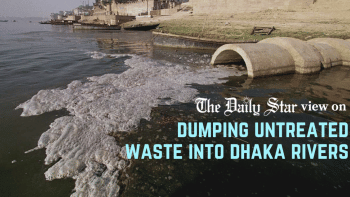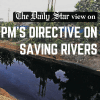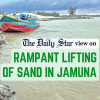‘NRCC has been kept weak on purpose’

Dr Manjur Ahmed Chowdhury, chairman of the Centre for Governance Studies (CGS) and former chairman of the National River Conservation Commission (NRCC), talks about the challenges in river conservation efforts in an exclusive interview with Naimul Alam Alvi of The Daily Star.
What were the major challenges that you faced during your tenure with the NRCC?
As the legal guardian of Bangladesh's entire river system, the NRCC's responsibilities are enormous. Unfortunately, the commission does not have the budget, resources or administrative power to ensure robust river conservation.
Currently, there is a huge demand for land to set up industries and development projects. So, many unscrupulous industrialists often resort to grabbing river foreshore or the actual rivers to set up establishments. This trend is not limited to industrialists and developers; a number of government organisations do the same.
While working to reclaim encroached riverland, I faced resistance from the highest level of bureaucracy, like the shipping ministry. Members of the commission were repeatedly harassed, intimidated, and threatened to be transferred.
In the face of inadequate resources and pressure from powerful individuals, it seemed to me that the NRCC is weak not only in terms of the law and executive power, but it has been intentionally kept that way.
Can you cite a few examples of river encroachment?
There are thousands of cases of illegal occupation of rivers, foreshore and riverland. Names and addresses of about 60,000 encroachers have been put up on the NRCC website, which is regularly updated.
However, many occupiers are basically squatters, who are largely victims of river erosion and other natural calamities. The threat they pose to rivers is insignificant compared to that by large industries, developers, politically influential people and government bodies.
For example, along the Balu River, powerful industrial groups have built structures on the river and riverbank, creating severe navigation and drainage problems. Meanwhile, encroachment along the Shitalakkhya River has reached an alarming level.
Despite being one of the country's major economic lifelines, rampant encroachment and uncontrolled release of domestic and industrial pollutants have significantly harmed the Karnaphuli River, with some illegal structures posing an existential threat to the water body. Some of these structures are the Karnafuly Dry Dock, the fishery market, and Mariners Park.
In a positive turn of events, the Bangladesh Inland Water Transport Authority (BIWTA) has done a tremendous job of evicting almost all the illegal occupants in the Buriganga, Turag and Tongi Khal rivers. However, there are still a few stubborn occupiers who couldn't be evicted.
Why didn't you evict these structures while you were the NRCC chairman?
These illegal structures are built and owned by very powerful people—those who have immense political clout and unlimited money, and can disregard the law with wanton abandon.
A case in point: the NRCC has been trying to stop the construction of Karnafuly Dry Dock since 2016. This particular structure was built over several years, illegally occupying at least 100 acres of the Karnaphuli River's foreshore and riverbed.
I wrote to the Chittagong Port Authority (CPA) and the Bangladesh Economic Zones Authority (BEZA) to cancel the land lease agreement with the dry dock. Unfortunately, they didn't take any action. I wrote to the Chattogram district administration with clear instructions to evict these illegal structures, but it didn't take measures either. Then I sent three written reminders to the deputy commissioner of Chattogram. Despite these reminders, the district administration took no steps.
To make matters worse, in the first week of March this year, the shipping ministry sent a letter to the Chattogram district administration, asking it not to evict this particular structure. It is regrettable that the very ministry entrusted to protect the rivers practically encouraged encroachers and justified their illegal activity.
Even the local politicians didn't protest these blatant onslaughts on their rivers. It seems to me that the river barons have taken hostage not only the administration but also the politicians in Chattogram.
Can you elaborate on the state of river pollution in our country?
Rivers around cities and industrial zones are extremely polluted. During the dry season, the Buriganga, Turag, Tongi Khal and Balu rivers appear to be flowing streams of toxic liquid. The dissolved oxygen level often drops down to 0.1 percent. At this dangerously low level, most aquatic creatures perish.
There are 18 rivers in the DAP area of greater Dhaka. From an ecological point of view, most of these rivers, at least during the dry season, are practically dead. In 2009, the Department of Environment (DoE) declared four rivers around Dhaka (Buriganga, Shitalakkhya, Turag and Balu) to be ecologically critical areas (ECAs). Unfortunately, as of today, the DoE has not taken any action to restore these rivers to their original state, as required by law when an area is declared to be ECA. I repeatedly requested DoE to take action to restore these rivers, but to no avail.
Why have we been failing to contain this pollution?
Dyeing and leather industries are the main sources of chemical pollution in our rivers and water bodies. The dyeing industry uses huge amounts of water to process their products. For example, to process one kg of jeans, it takes no less than 220 litres of water. This high volume of wastewater is expensive to treat properly. As a result, they often release this wastewater into canals, rivers, other water bodies, and even open fields. It is alleged that in some cases, the wastewater is injected underground.
There are a number of laws regulating these industries, but they are hardly applied properly. These industrial chemical pollutants pose serious health hazards. The regulatory agencies, mainly the DoE, are woefully lax, in some cases outright negligent, to bring the polluters to task.
Almost all municipalities and cities lack a proper waste management system in place. In the case of Dhaka city, responsibility for solid waste management lies with the two city corporations, while Dhaka Wasa is responsible for treating and disposing of human waste. It is estimated that Dhaka residents generate 4.5 million kg of stool and 15 million litres of urine daily. This huge amount of "black water" (stool, urine, toilet water), instead of being transported to a treatment plant, actually ends up in the surrounding Buriganga, Turag, Tongi Khal and Balu rivers.
In most parts of Dhaka, Wasa has failed to install sewerage lines to transport this black water to treatment plants. So, homeowners are compelled to connect their toilets to stormwater drains, which are linked to retention areas like Hatirjheel and canals. All the canals in the capital empty into the surrounding rivers. This means most of the black water ends up in our rivers through the canals. In any season, the water of these rivers is unfit for domestic use because of the extremely high concentration of faecal bacteria.
Curiously, Wasa has built a large treatment plant at a huge cost at Dasherkandi in eastern Dhaka and is running it round the clock. However, in the absence of a sewerage pipe system connected to it, what are they treating? Water from Hatirjheel? But Hatirjheel water is not supposed to have black water or any kind of wastewater in the first place.
Wasa's failure to install sewerage lines is nothing less than criminal negligence. And as time passes, it is becoming increasingly difficult, if not impossible, to install an extensive sewerage pipe system in this city.
While in office, you mentioned sand mining in Chandpur, referring to the involvement of powerful individuals including a certain minister, which The Daily Star also later investigated. Can you elaborate on this?
Sand is an important component of our development work. As we develop, the demand for sand will increase. Meanwhile, in many rivers, dredging is required to keep them navigable round the year. I am not against sand mining; I am against indiscriminate mining using unapproved equipment.
For instance, the only legal approach to sand mining is with dredgers that use the swing method. But this can mostly mine sand from the upper layers of the riverbed, which is not suitable for making concrete or plaster. For these, you'll need the coarse type of sand, which is usually extracted from deep under the bed of large rivers, using dredgers with drills and suctions. This type of dredging is illegal in the country.
Such unplanned sand mining with unapproved equipment causes river erosion, depletes aquatic biodiversity, and causes permanent damage to fish sanctuaries.
Despite the existence of laws to regulate sand mining, this sector has been taken over by politically powerful people who do not care about the law. They behave like a bunch of pirates ravaging our rivers just to make a quick profit.
Our most important hilsa sanctuary is in the Meghna River, which has been subject to indiscriminate sand mining by a gang for a decade. In March of 2022, I asked the Chandpur district administration to evict the sand mafia along with its accomplices from the Meghna, and it did so promptly. But the backlash was swift and sharp. All the officers who were involved in evicting them were promptly transferred to remote areas.
Such is the power of the politicians gone amok! In September this year, these groups again started mining sand in Meghna's hilsa sanctuary. When I strongly opposed this move, they retaliated at first by releasing some of my experienced officers, and then by pushing me out of my job.
Views expressed in this article are the author's own.
Follow The Daily Star Opinion on Facebook for the latest opinions, commentaries and analyses by experts and professionals. To contribute your article or letter to The Daily Star Opinion, see our guidelines for submission.

 For all latest news, follow The Daily Star's Google News channel.
For all latest news, follow The Daily Star's Google News channel. 










Comments